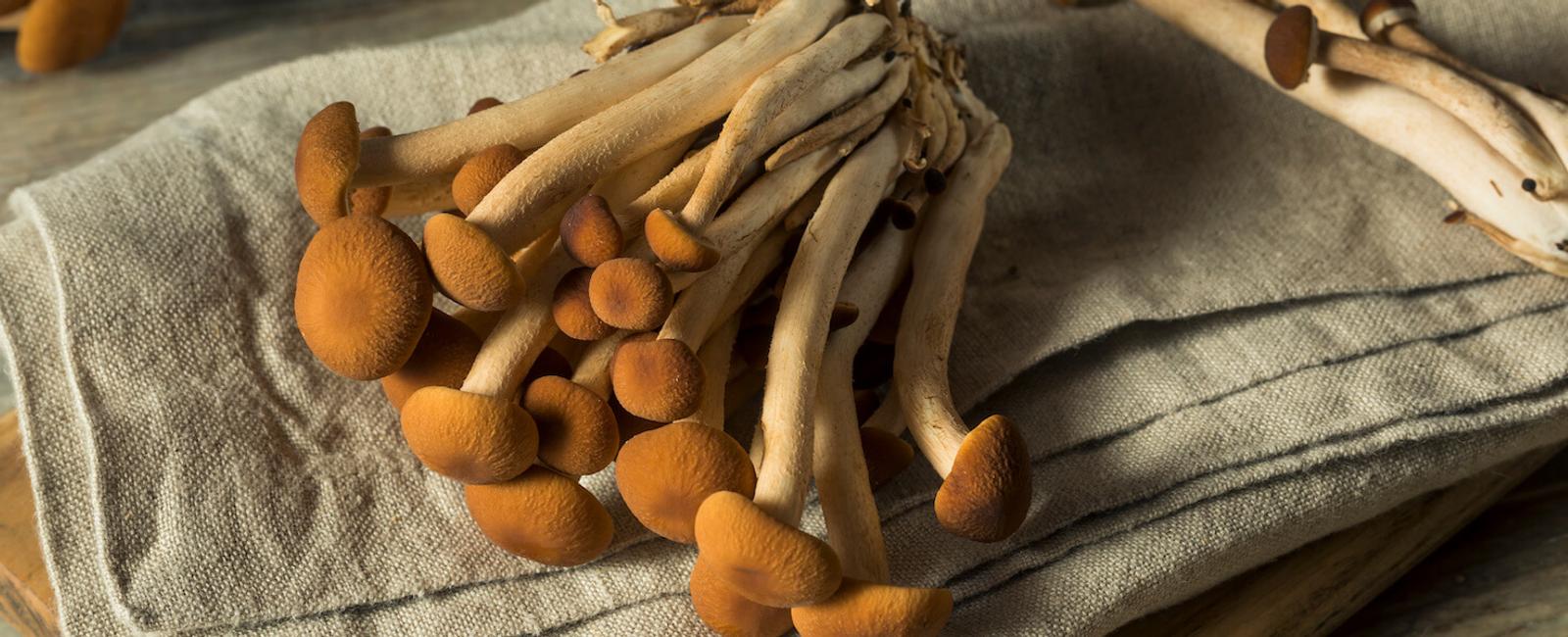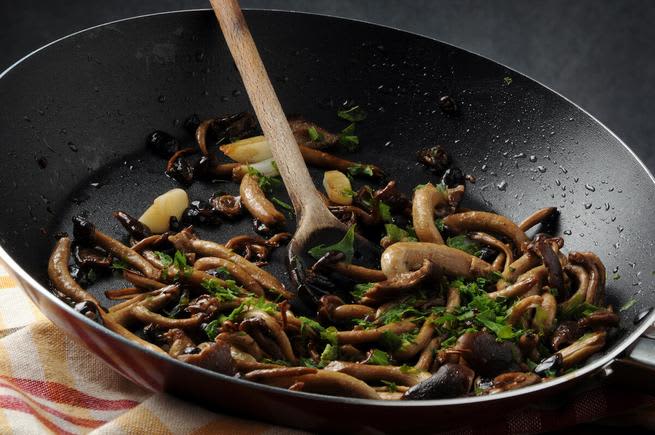

There are oodles of culinary mushrooms to explore, and each one is a unique way to enhance any dish. And one of these tasty delights is the pioppino mushroom.
In this guide, you’ll learn all about pioppino mushrooms. We’ll talk about their appearance, where they grow, how to ethically wildcraft them, and much more. Let’s dive in!
What are pioppino mushrooms?
Pioppino mushrooms (Agrocybe aegerita) are an edible wild mushroom. As taxonomy changes over time and with the latest research, you may also sometimes see pioppino mushrooms listed under their scientific name, Cyclocybe aegerita.
Common names for pioppino mushrooms include the velvet pioppino, Black Poplar mushroom, the Swordbelt agrocybe, and other regional names such as pioppino (Italian), yanagi-matsutake (Japanese), and Zhuzhuang-Tiantougu (Chinese) (1).
Psst: Pioppino means poplar in Italian!
What do pioppino mushrooms look like?
Pioppino mushrooms have smooth, rounded caps (sometimes so round they resemble a hemisphere) that can grow up to 12 inches in diameter.
These wild mushrooms change color as they mature, ranging from yellowish gray to grayish brown and even light brown, getting darker toward the center. While their gills are gray early in their growing process, as they age, they turn to a chocolate brown as their spores reach maturity (1). Their creamy white stems turn brown with age, like their mushroom caps (2).
Where do pioppino mushrooms grow?
Don’t be surprised if you see pioppino mushrooms growing in clusters on stumps in hardwood forests in the southeastern United States and Southern Europe. These shrooms favor cottonwoods, willows, poplar trees, maples, and box elders. In China, you can see them growing on tea-oil trees.
You can also grow pioppino mushrooms at home. Finding a suitable substrate is essential; look for oak or alder sawdust, although sawdust from any of their favorite hardwoods is likely to work equally well (1). A grow kit can also make mushroom cultivation at home even more manageable, so keep that in mind if you need help figuring out where to start.
Historical and traditional use of pioppino mushrooms

We know cultures worldwide have used medicinal mushrooms to heal and support the body. Hippocrates was classifying mushrooms as anti-inflammatory and wound healers around 450 BCE. Tao Hongjing, a 5th-century alchemist, described mushrooms that had already been used for several centuries when he was writing about them, while indigenous peoples in North America used puffball mushrooms as wound healers (3).
Some evidence suggests pioppino mushrooms were used in traditional Chinese medicine to support gut health and nourish the kidneys.
Unfortunately, we don’t have any further evidence directly connecting pioppino mushrooms to specific historical uses or traditional medicine schools, as mentioned above, so we aren’t able to draw any other conclusions about how they’ve been used historically.
Health benefits of pioppino mushrooms
While pioppino mushrooms may not be as well studied as other edible wild mushrooms (like lion’s mane, reishi, or chaga mushrooms), emerging evidence suggests these mushrooms are high in antioxidants, amino acids, and other nutrients.
Here are some of the benefits pioppino mushrooms may have:
- Anti-inflammatory
- Antifungal
- Antitumor
- Osteoporosis support
Further research has shown how properties in pioppino mushrooms prohibit cyclooxygenase enzyme activity, the same enzyme targeted by over-the-counter pain relievers (2).
Ethically wildcrafting pioppino mushrooms

While you may be eagerly awaiting the opportunity to search for your own wild pioppino mushrooms, learning the difference between foraging and ethically wildcrafting your mushrooms is essential.
Foraging is often used as a more general term for gathering wild food, whether berries, herbs, mushrooms, or other plants. While wildcrafting is similar, it’s defined as harvesting local resources for medicinal needs. And even though these terms are near synonyms, they differ significantly in their respective approach. Ethical wildcrafting is a far more intentional practice, considering both the short- and long-term consequences of harvesting resources from an environment.
Learning the local area
Before jumping into mushroom harvesting, it’s always wise to learn about the local area where you’ll be gathering your mushrooms. Awareness of any threatened or endangered mushroom species and if any potentially dangerous lookalikes are lurking in the area is helpful.
Appropriate mushroom identification is essential, so consider consulting a field guide if you need clarification on what you’re gathering, or better still, check in with a professional for guidance.
Be sure to look into whether or not you need any special permits, as some wild areas may require them.
Mushroom anatomy and proper harvesting
Properly harvesting your pioppino mushrooms starts by familiarizing yourself with mushroom anatomy.
Most of the time, when we think we’re seeing the whole mushroom, we’re only seeing part of it: the fruiting body. Just beneath the surface, there’s a new world to discover. The mycelium is a network of delicate plant filaments called hyphae that facilitate communication between mushrooms and trees. Information about the environment is communicated along this “wood wide web,” including environmental changes and when predators may be nearby.
As such, it’s vitally important that this sophisticated communication network is preserved as much as possible during the harvesting process. Raking the ground in search of mushrooms can damage mycelium, as can improper harvesting of mushrooms.
Spend time educating yourself on the best way to harvest the mushrooms you’re gathering and packing the appropriate tools. Some mushrooms may be best harvested by cutting their stems along the surface, while others may be gently twisted free from the soil.
Regardless of your chosen technique, mindfully harvesting your pioppino mushrooms will ensure their ability to grow for years to come.
Ecosystem preservation
It’s important to remember we’re not separate from the ecosystem; instead, we coexist with other flora and fauna. Remember this while wildcrafting your pioppino mushrooms, and take only what you need. Birds, deer, insects, rodents, and other creatures rely on mushrooms as a food source, and overharvesting could cause an imbalance in the local environment that could take years to recover from. Being mindful of how (and how much) you’re gathering means we all get to enjoy the gifts nature offers together.
How can you enjoy pioppino mushrooms?

Pioppino mushrooms are a delight for any home cook. With a nutty flavor and firm texture, these shrooms are versatile and hold up well in various dishes. From stir-fry to risotto, pasta, soups, stews, meat dishes, and even simple sauteing, these mushrooms will quickly become a new favorite. Here are some of our favorite mushroom recipes that make it easy to enjoy every bite of these fresh mushrooms!
Pioppino mushroom soup
When you’re in the mood for mushroom soup, look no further than this cozy pioppino mushroom soup with pancetta, spring peas, and green onions. It’s weeknight-friendly, too, cooking up in about 20 minutes. Pancetta and onions are sauteed together while the peas are gently simmered in broth until tender, while the pioppino mushrooms are sauteed until they release their liquid but are firm. This simple soup couldn’t be easier.
Crispy mushroom fries
Craving french fries but looking for a healthier alternative? Keep it simple by sauteing your pioppino mushrooms until crispy. A blend of olive oil and butter adds flavor, creating the perfect side dish for red meats or other proteins. Add variety and make a mushroom medley by adding oyster mushrooms or shiitake mushrooms. These pan-fried mushrooms can also be spread on toast for a quick and savory snack. Finish with freshly chopped tarragon for the ultimate in umami-rich flavor.
Creamy mushroom gnocchi
There’s nothing quite like tucking into the comfort of creamy mushroom gnocchi, whether you’re enjoying a peaceful evening of solo cooking or entertaining friends and family. This easy recipe comes together in under an hour (40 minutes, to be precise) and is ideal for using any fresh pioppino mushrooms you have on hand. Chicken broth, heavy cream, and dry white wine create the foundation of an unforgettable cream sauce kissed with garlic, onions, and parmesan cheese. It’s the perfect side dish or main event (or even midnight snack—we won’t tell).
Psst: Depending on where you live, you may find pioppino mushrooms in your local supermarket. If not, check out farmer’s markets or other specialty retailers where you can find gourmet mushrooms.
Pioppino mushrooms: A versatile culinary mushroom
Pioppino mushrooms are endlessly versatile in the kitchen, a dream come true for cooks hoping to impart earthy, sweet, umami flavors into any dish. With a bevy of potential health benefits, these little brown mushrooms are a natural fit for anyone looking to support their body in a delicious and savory way.
Still craving mushrooms? Keep up with all the latest news and breakthroughs on shroomer. You’ll get all the details on psychedelic and medicinal mushrooms from all over the world.
References
- Stamets, Paul. Growing Gourmet and Medicinal Mushrooms. Ten Speed Press, 2011. https://fungi.com/collections/books-by-paul-stamets/products/growing-gourmet-and-medicinal-mushrooms
- Mushroom Identification - Ultimate Mushroom Library. “Cyclocybe Aegerita: The Ultimate Mushroom Guide,” n.d. https://ultimate-mushroom.com/edible/97-cyclocybe-aegerita.html
- Stamets, Paul, and Heather Zwickey. “Medicinal Mushrooms: Ancient Remedies Meet Modern Science.” Integr Med (Encinitas) 13, no. 1 (February 2014). https://www.ncbi.nlm.nih.gov/pmc/articles/PMC4684114/


